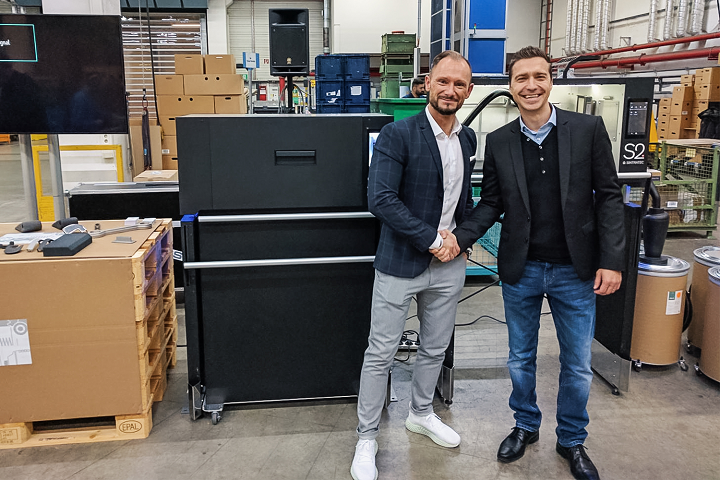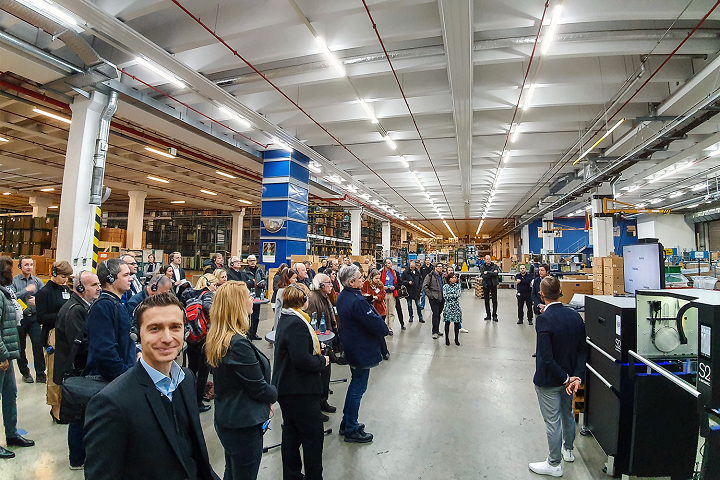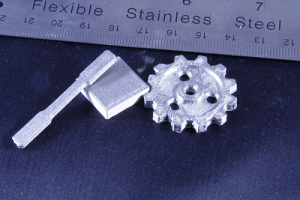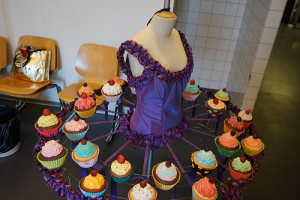3D Printing Industry News Sliced: Sonda SYS, Sintratec, Nanofabrica, DMG MORI, RPS, PostProcess
Sintratec: Hybrid Materials Laboratory Case Study Focuses on Porous Ceramic Structures
“We will benefit more and more from the possibilities of additive technologies,” – Professor Alberto Ortona
Sintratec has just released a case study featuring The Hybrid Materials Laboratory at the University of Applied Sciences and Arts of Southern Switzerland (SUPSI) and their latest work as they create new 3D printing composites. Headquartered in Ticino, Switzerland, SUPSI used a variety of different equipment during their extremely sophisticated development phase, to include the Sintratec Kit.
With a focus on reusability, especially for applications like aerospace, Professor Alberto Ortona, head of the Hybrid Materials Laboratory at the Institute for Mechanical Engineering and Materials Technology (MEMTi) at SUPSI, explains why they are engaged in their current research:
“A space vehicle enters the atmosphere from a low earth orbit with a speed of roughly 30’000 km/h. The vehicle is then decelerated by the friction of air which converts its kinetic energy into heat. As a result, the outer surface gets extremely hot.”
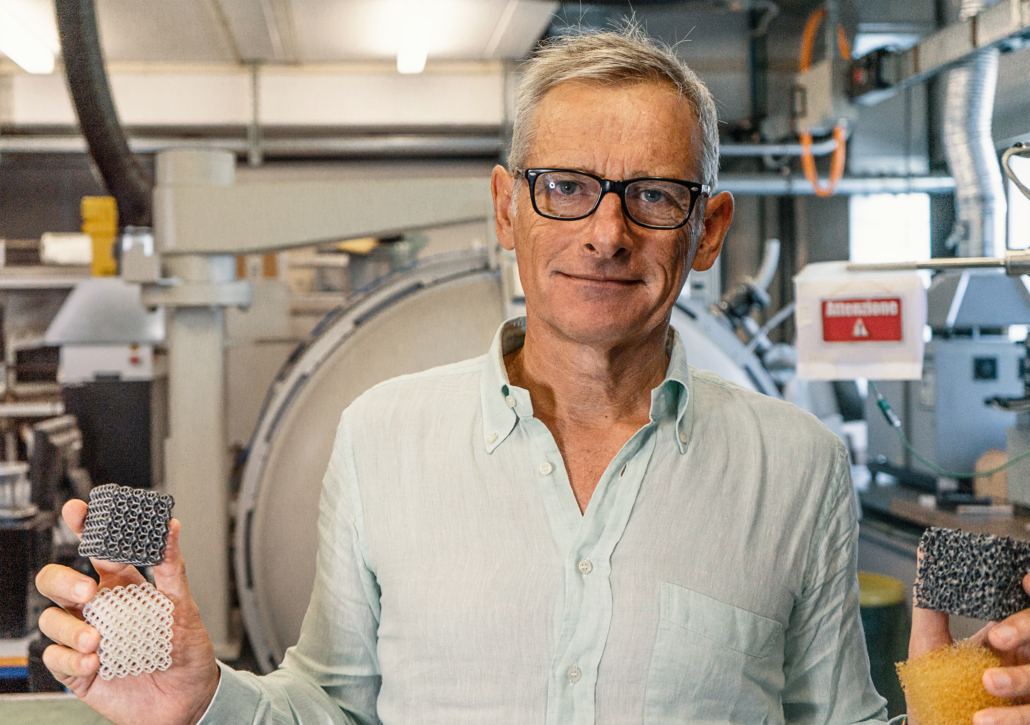
Professor Alberto Ortona, Director of the Hybrid Materials Laboratory at the Institute for Mechanical Engineering and Materials Technology (MEMTi) at SUPSI
The MEMTi team realized that new hybrid materials needed to be developed to prevent structures from burning on their re-entry mission; for example, parts made from advanced ceramics can tolerate harsh environmental conditions over the long-term, like high temperatures and thermal shock. These types of materials can also be re-used from mission to mission, rather than replaced after every single expedition.
Ceramic Matrix Composites (CMC) are comprised of high-quality, lightweight lattices that often cannot be produced through any other method than additive manufacturing; in fact, for some of the new parts they are creating there is simply no other route than through additive manufacturing.
The team was also involved in THOR, an EU research project. They developed a series of ‘complex sandwich structures’ from ceramics, meant to be cooled via gas flows—further allowing space vehicle parts to be manipulated through thermal protection systems.

Prototypes of catalyst substrates which swirl the exhaust gas flow: The two gyroid structures have the same size but are 3D printed with different parameters. This leads to diverse micro-porosities and mechanical properties.
Currently the researchers are creating composites far beyond the norm, and even with porous materials, all useful in applications such as:
- Heat exchangers
- Heating burners
- Solar systems
- Catalytic converters
- Water filtration systems
SLA 3D printers have been available at the Hybrid Materials Laboratory for 15 years, but at this point the researchers point out that they require new AM processes—like selective laser sintering (SLS) for fabrication of more complex designs like their porous ceramics and parts called gynoids.
“Thanks to the open parameters of the Sintratec Kit, we were able to define the 3D printed objects with the best properties required to apply the ceramic coating optimally to the template,” said Oscar Santoliquido, research assistant at MEMTi. “The SLS technology allows us to create complex grid structures quickly and easily.”
The Sintratec Kit is designed for use in the following fields:
- Medical
- Mechanical engineering
- Rapid prototyping
- Industrial design
- Durable spare parts
- Education
- Research
- Model building
Find out more about the case study here.
Ceramics have been associated with 3D printing now in many different projects, from bioinspired materials to parts produced on the nanoscale, other composite materials, and more. What do you think of this news? Let us know your thoughts! Join the discussion of this and other 3D printing topics at 3DPrintBoard.com.
[Source / Images: Sintratec]
The post Sintratec: Hybrid Materials Laboratory Case Study Focuses on Porous Ceramic Structures appeared first on 3DPrint.com | The Voice of 3D Printing / Additive Manufacturing.
Sintratec Providing 3D Printing Support to Daimler Buses for Service Bases
 The commercial vehicles segment of Mercedes-Benz parent company Daimler AG has fully integrated 3D printing into the development process and series production workflow for several of its divisions, such as Daimler Trucks North America and Daimler Trucks & Buses; in fact, the latter already features 3D printed parts built into the interior of its buses.
The commercial vehicles segment of Mercedes-Benz parent company Daimler AG has fully integrated 3D printing into the development process and series production workflow for several of its divisions, such as Daimler Trucks North America and Daimler Trucks & Buses; in fact, the latter already features 3D printed parts built into the interior of its buses.
According to its website, Daimler Buses is the “leader in its most important traditional core markets,” and is now expanding its use of 3D printing for bus parts, collaborating with SLS leader Sintratec for the initiative.
“With 3D printing the Daimler bus division can respond quickly, flexibly, economically and environmentally friendly to urgent customer needs,” Ralf Anderhofstadt, the Head of the Center of Competence Additive Manufacturing, Daimler Buses, stated in a Sintratec press release. “The advantages of additive technologies, especially with regards to spare parts, are evident.”
![]() Rather than utilizing external service providers, this coming year Daimler Buses will be setting up its own personal service bases, with the 3D production support of Sintratec. These 3D printing centers, to be used for the fabrication of both individualized components and spare parts, are a smart idea in terms of economics and logistics – it will only take a few days, rather than several months, to manufacture and deliver a 3D printed part, which produces much less waste and costs far less money.
Rather than utilizing external service providers, this coming year Daimler Buses will be setting up its own personal service bases, with the 3D production support of Sintratec. These 3D printing centers, to be used for the fabrication of both individualized components and spare parts, are a smart idea in terms of economics and logistics – it will only take a few days, rather than several months, to manufacture and deliver a 3D printed part, which produces much less waste and costs far less money.
Swiss high-tech company Sintratec develops and manufactures precise SLS 3D printers for professional purposes. The company’s materials are temperature-resistant and resilient, and its technology allows customers plenty of design freedom in creating complex objects for 3D printing.
Sintratec’s first desktop SLS system was successfully crowdfunded on the Indiegogo platform back in 2014, and the company has since moved on to bigger printers, introducing its modular, industrial Sintratec S2 system at last year’s formnext. This affordable, end-to-end SLS solution is perfect for education and training, in addition to fabricating prototype parts and small and medium-sized series.
The smart S2 has a modular construction, with the build chamber inside the Material Core Unit, but easily removable from the Laser Sintering Station. The system also includes an integrated powder mixing function, a Blasting Station and Polishing Station, and an additional Material Core Unit for convenient powder handling.
Now, Sintratec is excited to help contribute to the bus industry’s continuing digitalization. Recently, the S2 system was delivered to the Neu-Ulm, Germany production site of EvoBus GmbH, Daimler AG’s largest European subsidiary. The 3D printer will be used at this location to, as the release states,” convey technological know-how” at Daimler Buses’ new 3D printing centers, and to help advance the development, and optimization, of 3D printing materials.
“Special thanks to the entire EvoBus GmbH team for letting Sintratec participate in this outstanding event and present our vision of the digital factory as well as our Sintratec S2 system,” said Gabor Koppanyi, Sintratec’s Head of Marketing & Sales. “We are very proud of this partnership and are looking forward to more fantastic projects where we can shape the future together.”
What do you think about this news? Discuss this story and other 3D printing topics at 3DPrintBoard.com or share your thoughts in the Facebook comments below.
The post Sintratec Providing 3D Printing Support to Daimler Buses for Service Bases appeared first on 3DPrint.com | The Voice of 3D Printing / Additive Manufacturing.
Daimler to 3D print spare bus parts using Sintratec S2
RAPID 2019: Opening Day and Opening Ceremony
The first day of the RAPID + TCT conference was bristling with activity. The first day mostly consists of lectures and workshops. At some other conferences, this is a secondary affair but here in Detroit we’re really seeing this to be the meat and bones of the conference on day one. There were a tonne of conference events and workshops today from the very general to the highly specific. There were workshops on casting materials for automobiles, implementing quality systems for medical devices, metal printing, and how to use 3D printers in hospitals and biomaterials. A lot of these were almost all day events with multiple speakers that were almost conferences in and of themselves.
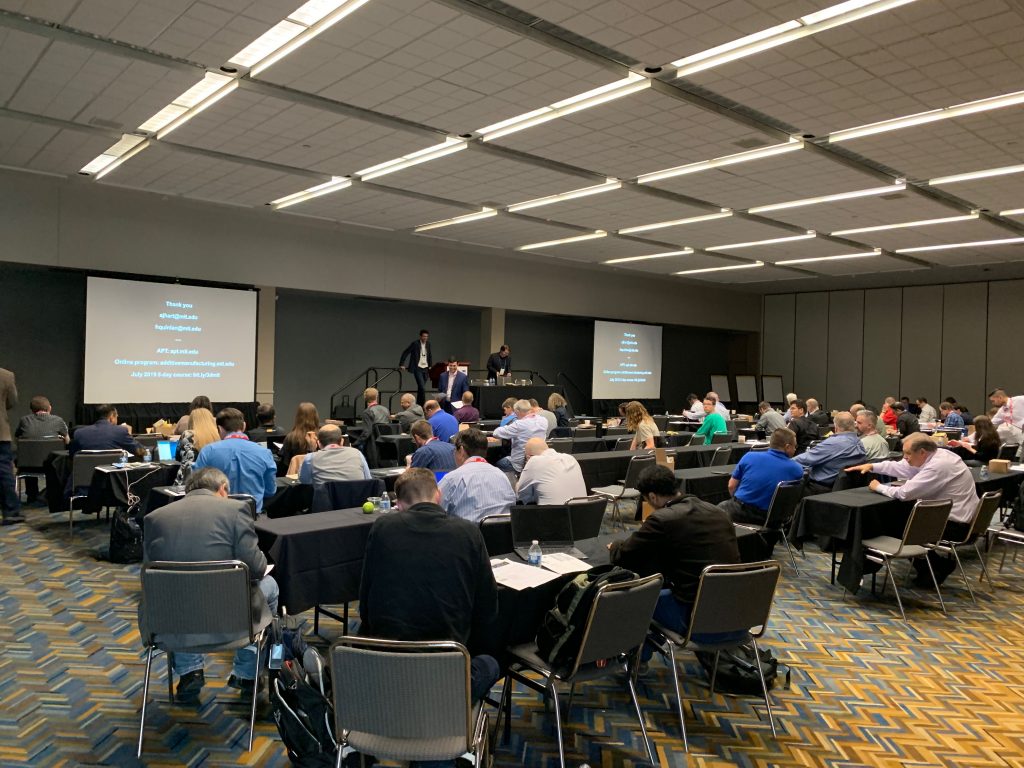
Professor Hart’s Workshop
Professor John Hart gave a great presentation on applying materials and processes to making 3D printed parts throughout the life cycle. This workshop was great for people trying to start business cases internally with 3D Printing. It covered things such as costing and the relationship with the design to the final part. Walking around through all the workshop rooms I was really spoilt for choice. I really do believe that the “workshop day” at Rapid is underappreciated and under-visited. There are people here and there is knowledge here that you really can not find anywhere else. Do not miss this first day if you want to come next year! Having said that there were thousands of attendees for the different workshops and the first day already felt like a big conference.
Things started to get much bigger when we went to the Ballroom for the main opening ceremony.

Erika Berg of Carbon and Vitorrio Bologna of Riddell
Erika Berg of Carbon and Vitorrio Bologna of Riddell keynoted on how their companies were working together to try to make individualized mass customized helmet liners for football helmets. Individual helmets and other sports gear could become a huge application for 3D printing. Using one build of a Carbon L1 3D printer all of the distinct parts of a helmet liner can be produced. The data comes from a scan of a players head which is now done by 3D scanners but Riddell wants to go to a home scan solution for that in the future. The data gets sent to Carbon which then calculates the optimal design of the helmet cellular structure which may have 140,000 struts. Riddell already has 4000 3D scans to work with as well as thousands of readouts of player crashes to tell them how to design the helmets. In the future, the team wants to put accelerometers and other sensors in all helmets to acquire more data that would let them produce better helmets. They want to implement this for all football players from the Pro’s and college to the youth level. All in all the approach with cellular structures and data gathering seems very sound and this is a huge application for 3D printing if it goes forward. I just have questions with the Carbon business model. If Riddell leases the printers if Carbon slices the files if Carbon determines the optimal structure of the helmet then what is Riddell?
If we look at firms such as Nike: Nike is the brand, they design the shoes and know how to market and brand them. Others manufacture. Now Riddell is outsourcing key ownership of the core design competency that they and firms like Nike have. Won’t they be tied to Carbon forever? Isn’t the core part of their helmets the connection between the “crash test data”, head scans and how to create the cellular structures for the helmets?
Carl Dekker of Met-L-Flo then came on. He is the current ASTM 42 Chairman and Advises SME. He presented awards on the best research paper and project. Fast Robotic Soft Matter 3D Printing for Neurosurgical Phantoms Fabrication by Michael Chang was the winner of the Dick Aubin Distinguished Paper Award. On the 23rd you can see him present it. On the research project side the winner was The Copper Cooler: Heat Sink for CPU’s by Lisa Brock and Gitanjali Shanbhag.
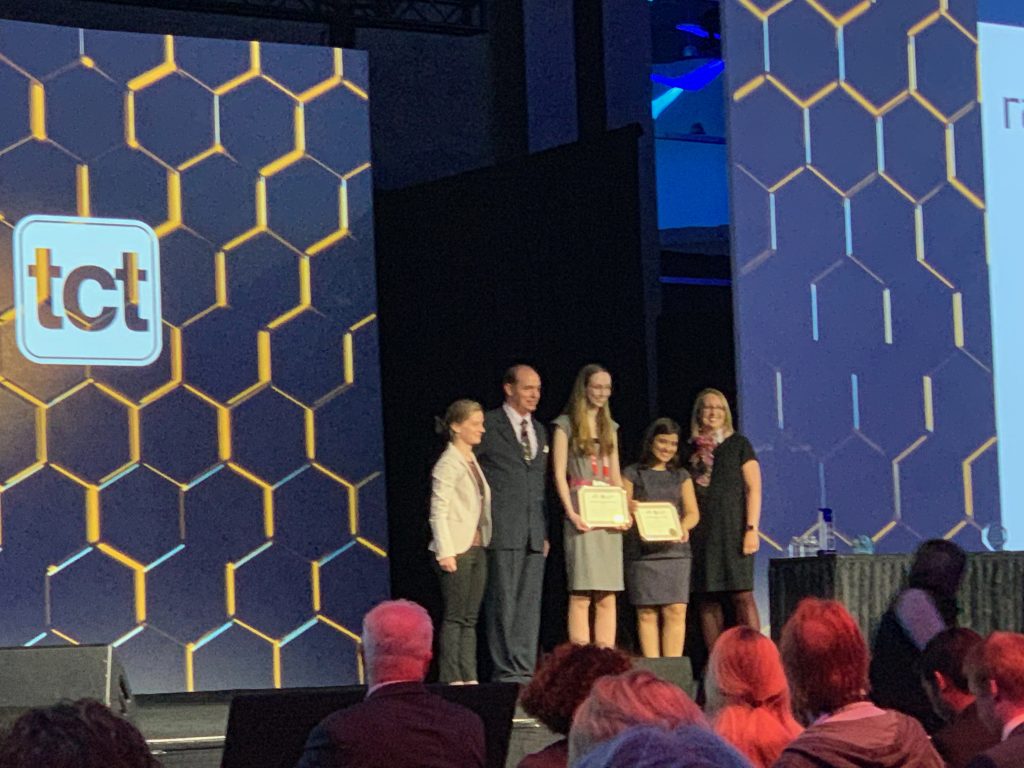
Industry consultant Todd Grimm then took us through the companies that had applied for the innovation award and revealed that 48 out of 400 exhibitors would be on a list to be considered. He then went on to detail all of the firms and their particular innovation in order to tell everyone “What’s New” at Rapid. I thought that this was a particularly helpful presentation for visitors. He also mentioned that the finalists for the innovation award would be: Digital Alloys, e3D, Fabrisonic, Formalloy, NXT Factory, Rapidia, Sigma Labs and Sintratec. I for one really can’t choose there are a number of very deserving firms there and also some very sympathetic teams. Usually one could guess but this time its wide open as far as I’m concerned.
Then the SME Industry Achievement Award was revealed. The winner was Ely Sachs. Ely was a Desktop Metal co-founded but also a core inventor of the “MIT patent” inkjet head based 3D printing technologies years earlier and a more than deserved winner! This was a very exciting almost my brain runneth over first day here in Detroit and I can’t wait to discover more.
Best Non-FFF 3D Printer of the Year 2019: the Wildcard Update
Sintratec donates SLS Kit to Southern Union’s 3D printing programme
3D Printing News Briefs: April 6, 2019
We’re starting off today’s 3D Printing News Briefs with a product launch announcement – 3YOURMIND launched the full version of its Agile MES software software this week at AMUG 2019. Moving on, Sintratec will present its latest SLS 3D printer at RAPID + TCT next month in Detroit, Tiamet3D has joined Ultimaker’s material alliance program, and Sciaky entered into an agreement with KTM Consultants. Xometry just announced some important certifications, and nScrypt is 3D printing titanium parts. Moving on to the world of art and theatre, the Zurich Opera House is 3D printing props, and artist Andrea Salvatori worked with WASP to create a 3D printed art collection.
3YOURMIND Launched Agile Manufacturing Execution System (MES) Software
 After spending five years providing order management systems to scale for some of the industry’s AM leaders, 3YOURMIND has finally moved its software solutions to a production environment with the launch of its Agile Manufacturing Execution System (MES) earlier this week at AMUG 2019. The software uses smart part prioritization, rapid scheduling, order tracking, and custom AM workflow creation to improve machine utilization and make production more efficient, and an Early Access Program (EAP) allowed the company to receive direct feedback on its Agile MES software from representatives at companies like EOS and Voestalpine. The next step will be working to finalize machine connectivity.
After spending five years providing order management systems to scale for some of the industry’s AM leaders, 3YOURMIND has finally moved its software solutions to a production environment with the launch of its Agile Manufacturing Execution System (MES) earlier this week at AMUG 2019. The software uses smart part prioritization, rapid scheduling, order tracking, and custom AM workflow creation to improve machine utilization and make production more efficient, and an Early Access Program (EAP) allowed the company to receive direct feedback on its Agile MES software from representatives at companies like EOS and Voestalpine. The next step will be working to finalize machine connectivity.
“For Agile Manufacturing, the Agile MES will need to both GET and PUSH data from all major AM machines and post-processing systems. We are already integrating the data from several vendors into our software and expect to support all major machines,” explained 3YOURMIND’s CEO Stephan Kühr. “Receiving and processing machine data allows us to provide the documentation that is needed for quality assurance and to increase the repeatability of additive manufacturing. Pushing data directly to machines will be the key to automating production.”
Sintratec Showcasing New SLS 3D Printer at RAPID + TCT
 A few months ago, Swiss SLS 3D printer manufacturer Sintratec introduced its scalable, modular Sintratec S2. Now, the company will be presenting the printer in the US for the first time next month at RAPID + TCT in Detroit, which will also be Sintratec’s first time attending the massive event. What makes the Sintratec S2 stand out is its closed-loop workflow, as the complete system covers every process with its three modules: the Laser Sintering Station (LSS), the Material Core Unit (MCU), and the Material Handling Station (MHS). The 3D printer offers quick material changes, a 4K camera for print monitoring, improved ergonomics, and effective heat distribution through its cylindrical printing area and ring lamps.
A few months ago, Swiss SLS 3D printer manufacturer Sintratec introduced its scalable, modular Sintratec S2. Now, the company will be presenting the printer in the US for the first time next month at RAPID + TCT in Detroit, which will also be Sintratec’s first time attending the massive event. What makes the Sintratec S2 stand out is its closed-loop workflow, as the complete system covers every process with its three modules: the Laser Sintering Station (LSS), the Material Core Unit (MCU), and the Material Handling Station (MHS). The 3D printer offers quick material changes, a 4K camera for print monitoring, improved ergonomics, and effective heat distribution through its cylindrical printing area and ring lamps.
“The Sintratec S2 will boost the design of applications and gives the user the opportunity to set foot in small series production as well. And that for an unusually attractive price-performance ratio,” said Sintratec CEO Dominik Solenicki.
“With the Sintratec S2 solution we will be opening new opportunities for companies of any size.”
The price for the Sintratec S2 starts at $39,900, and you can see it for yourself at Sintratec’s booth 1753 at RAPID + TCT from May 20-23.
Tiamet 3D Joins Ultimaker’s Material Alliance Program
 Last year, Dutch 3D printing specialist Tiamet 3D, founded in late 2014, worked with Finland-based Carbodeon to develop the first nanodiamond-enhanced 3D printing filaments, which went on the market in September. Now the company has joined Ultimaker as a partner in its Material Alliance Program. Together, the two will offer end-users simple one click downloads of Tiamet’s ULTRA Diamond material profile, which is now available on Ultimaker’s Cura software. This collaboration is formally backed by Tiamet’s manufacturing partner Mitsubishi Chemical Performance Polymers (MCPP Netherlands).
Last year, Dutch 3D printing specialist Tiamet 3D, founded in late 2014, worked with Finland-based Carbodeon to develop the first nanodiamond-enhanced 3D printing filaments, which went on the market in September. Now the company has joined Ultimaker as a partner in its Material Alliance Program. Together, the two will offer end-users simple one click downloads of Tiamet’s ULTRA Diamond material profile, which is now available on Ultimaker’s Cura software. This collaboration is formally backed by Tiamet’s manufacturing partner Mitsubishi Chemical Performance Polymers (MCPP Netherlands).
Reid Larson, the Director and Co-Founder of Tiamet 3D, told us about some of the highlighted specs of its ULTRA Diamond material, including no additional nozzle wear, 6300 mpa stiffness, low moisture absorption and friction, improved thermal conductivity, and twice “the temperature resistance of normal PLA, Annealed goes to 125C HDT.” You can purchase one kg of ULTRA Diamond filament for €59.
Sciaky Increasing Sales Efforts Through New Agreement
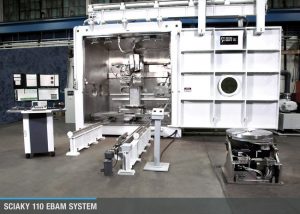 In an effort to increase the sales efforts of its Electron Beam Additive Manufacturing (EBAM) solutions in Australia, the Middle East, and New Zealand, Sciaky, Inc. has entered into an agreement with KTM Consultants, founded by metallurgist Trent Mackenzie in 2015. In terms of sheer work envelope, Sciaky’s massive EBAM systems are the industry’s most widely scalable metal 3D printing solution, able to produce parts ranging from 8 inches to 19 feet at gross deposition rates of up to 25 lbs of metal an hour. Additionally, its Interlayer Real-time Imaging and Sensing System (IRISS) is the metal 3D printing market’s only real-time adaptive control system capable of sensing and digitally self-adjusting its deposition.
In an effort to increase the sales efforts of its Electron Beam Additive Manufacturing (EBAM) solutions in Australia, the Middle East, and New Zealand, Sciaky, Inc. has entered into an agreement with KTM Consultants, founded by metallurgist Trent Mackenzie in 2015. In terms of sheer work envelope, Sciaky’s massive EBAM systems are the industry’s most widely scalable metal 3D printing solution, able to produce parts ranging from 8 inches to 19 feet at gross deposition rates of up to 25 lbs of metal an hour. Additionally, its Interlayer Real-time Imaging and Sensing System (IRISS) is the metal 3D printing market’s only real-time adaptive control system capable of sensing and digitally self-adjusting its deposition.
“I was immediately drawn to Sciaky’s EBAM technology because of its unique and robust capabilities. Industrial manufacturers of large metal parts need to explore the significant advantages that technologies like EBAM offer. It is truly a game-changer,” said Mackenzie.
Xometry Announces New Industry Certifications
 Digital manufacturing marketplace Xometry announced that it has just received ISO 9001:2015 and AS9100D certifications – some of the most rigorous, widely-recognized quality management designations in the industry. ISO 9001 helps organizations meet the needs and expectations of their customers in terms of quality management, while AS9100 meets customer demands in the exacting aerospace and defense industries. The company went through a major audit as part of the process, and its achievement definitely reflects how committed Xometry is to providing quality.
Digital manufacturing marketplace Xometry announced that it has just received ISO 9001:2015 and AS9100D certifications – some of the most rigorous, widely-recognized quality management designations in the industry. ISO 9001 helps organizations meet the needs and expectations of their customers in terms of quality management, while AS9100 meets customer demands in the exacting aerospace and defense industries. The company went through a major audit as part of the process, and its achievement definitely reflects how committed Xometry is to providing quality.
“We are thrilled to receive this designation. Our team members have a passion for providing great customer service while following the disciplines that give our customers peace of mind regarding on-time delivery, quality, and continuous improvement. It is yet another step towards achieving industry “best in class” status and being able to meet the expanded needs of our customers,” stated Xometry COO Peter Goguen.
nScrypt Develops Proprietary Method for 3D Printing Titanium
Florida manufacturer nScrypt, which develops high-precision Micro-Dispensing and Direct Digital Manufacturing equipment and solutions, is now focusing on repeatable 3D printing of metals for the medical, defense, and aerospace industries. The company has created a proprietary method for 3D printing titanium parts, which tests have shown display densities comparable to wrought parts. This method could easily work with other metals as well, such as copper, Inconel, and stainless steel, and nScrypt’s Factory in a Tool (FiT) systems can finish or polish areas with high tolerance features using its integrated precision nMill milling head. nScrypt’s Brandon Dickerson told us that the company expects to release more details on this later in 2019.
“The parts were printed with our SmartPump
Micro-Dispensing tool head, which runs on any of our systems,” Dickerson told 3DPrint.com. “The parts shown in the photos were printed on our DDM (Direct Digital Manufacturing) system, also known as our Factory in a Tool (FiT) system, which can run 5 tool heads at the same time, including our Micro-Dispensing, Material Extrusion, micro-milling, and pick-and-place tool heads. The parts were sintered after the build and the current densities are in the high 90% range. We expect our system to appeal to customers who want to do Direct Digital Manufacturing and need strong metal parts, but cannot build them with a powder bed system (for example, if the geometry would trap powder inside) or prefer not to use a powder bed system (for example, if they want a cleaner system).”
Zurich Opera House 3D Printing Props with German RepRap
Switzerland’s largest cultural institution, the Zurich Opera House, puts on over 300 performances a year, but the behind-the-scenes magic happens in the studios and workshops, where the props and costumes are made. The opera house uses the x400 3D printer from German RepRap, with assistance from Swiss reseller KVT- Fastening, to support its creative work by fabricating props and molds. This affords the institution more creativity and flexibility, as they can design objects to their exacting needs in 3D modeling programs, which also helps save on time and money. The opera house currently uses PLA, which is easy to handle, offers a variety of colors, and is flame retardant – very important in a theatrical setting.
“Often, the wishes and ideas of costume and stage designers are very diverse and sometimes extraordinary. It often happens that props are not available in the way designers have it in their minds. This is where the 3D printer is perfect for,” said Andreas Gatzka, director of theater sculpture at the Zurich Opera House.
“There are a lot of great benefits. Special wishes of stage and costume designers can be realized quickly as well as a short-term change of the objects, for example larger, smaller, longer, shorter, or whatever is needed.”
3D Printed Art Collection
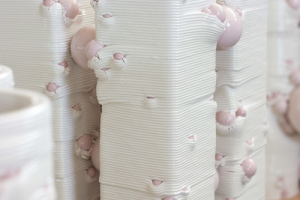 Artist Andrea Salvatori 3D printed the eye-catching pieces for his new collection, titled Ikebana Rock’n’Roll, using the Delta WASP 40100 Clay 3D printer – designed by WASP to be used by ceramic and clay artists. The collection just opened on stage at THE POOL NYC in Milan last week, and will be available to view until May 31st. With these 3D printed vases, Salvatori wanted to use “a miscellany of ceramic insertions” to mess with the high quality shapes 3D printing can achieve by adding asymmetry.
Artist Andrea Salvatori 3D printed the eye-catching pieces for his new collection, titled Ikebana Rock’n’Roll, using the Delta WASP 40100 Clay 3D printer – designed by WASP to be used by ceramic and clay artists. The collection just opened on stage at THE POOL NYC in Milan last week, and will be available to view until May 31st. With these 3D printed vases, Salvatori wanted to use “a miscellany of ceramic insertions” to mess with the high quality shapes 3D printing can achieve by adding asymmetry.
“The process of depositing the material and setting the spheres is a central theme in the Ikebana Rock’n’Roll collection, to the point of convincing Salvatori to name the works “Composition 40100”, as if they originated from a musical dialogue of the most varied tones. The artist upsets the algorithm reiterated slavishly by the machine with imperfect musical accents, the result from time to time of spontaneous actions and reasoned processes,” WASP wrote in a blog post.
“The ikebanes, proposed by Andrea Salvatori in the exhibition, transcend the experimental limits of an abstract investigation, representing a concrete territory in which 3D printing and ceramic art co-exist synergistically. The Master challenges the confrontation with the public, becoming also in this sector, precursor of a new genre in which WASP feels itself fully represented.”
Discuss these stories and other 3D printing topics at 3DPrintBoard.com or share your thoughts in the Facebook comments below.


